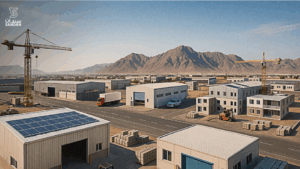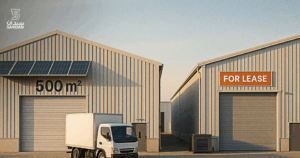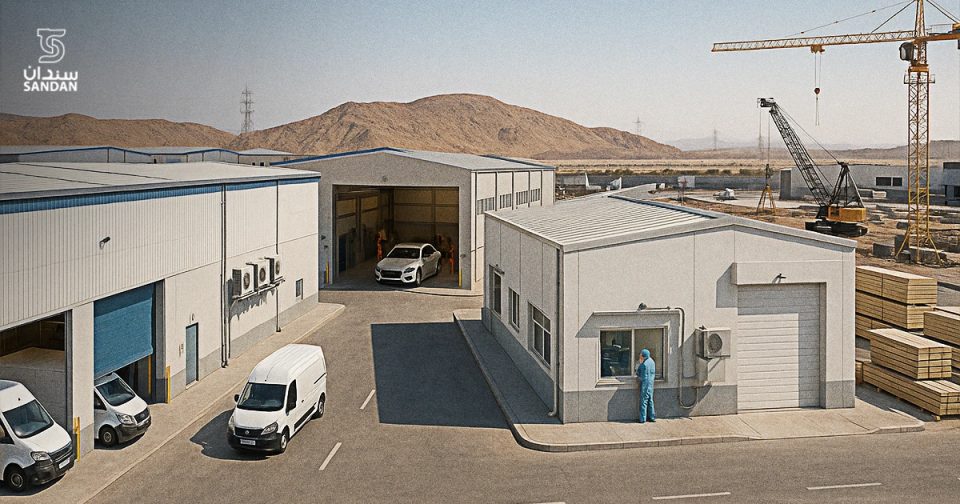Introduction
Muscat’s industrial property scene has done a full 180 since the pandemic years. Warehouse vacancy that once felt endless is now inching below eight percent, and freehold prices at hubs like Sandan Industrial City keep nudging upward as new tenants race to lock in space. What’s driving the squeeze? Five high-growth niches—from e-commerce fulfilment to clean-tech prefab yards—are soaking up floor area faster than developers can pour concrete. If you’re scouting opportunities or trying to time a purchase, understanding which industrial sectors Muscat demand is set to skyrocket next will give you a clear edge.
This guide unpacks the data behind each sector, translates it into real-estate specs (height, power, floor loading) and explains where Sandan’s ready-built stock fits the brief. By the end you’ll know exactly which unit types to shortlist, how rents and freehold prices are likely to move, and where the sweet spot lies for UAE-based investors chasing both yield and capital growth.
Key takeaways at a glance
- Five sectors—last-mile logistics, cold-chain food, EV/auto parts, light pharma and modular construction—are set to drive most of Muscat’s new industrial take-up between now and 2027.
- E-commerce alone is pushing 6 percent annual rent growth for sub-1 000 m² units along the Muscat Expressway corridor.
- Sandan Industrial City ticks four of the five sector boxes with freehold workshops (55–500 m²) and larger divisible boxes up to 1 200 m².
- New rooftop-solar and chilled-water incentives trim operating costs for cold-store and light-manufacturing users, widening the gap with UAE utility tariffs.
- A zero-interest, 18-month instalment plan lets buyers own space for less monthly outlay than a comparable lease—useful when interest rates remain sticky.
- Why Muscat is back on every site-selector’s radar
Talk to any logistics manager in Dubai and you’ll hear the same refrain: nine-percent corporate tax and creeping industrial rents are squeezing margins. Cross the border into Oman and the math flips. The non-oil tax rate in Muscat is still zero, utility tariffs sit 30–40 percent below UAE benchmarks, and the Expressway upgrade has cut the Muscat-to-Hafeet border haul to a consistent three hours. Add Royal Decree 38/2025—which finally lets foreign-owned companies hold a freehold deed inside designated industrial parks like Sandan—and suddenly the capital looks like the Gulf’s best-value distribution hub. Investors chasing industrial sectors Muscat demand are discovering they can own a 500 m² warehouse for the same monthly outlay they used to hand over as rent in Dubai South.
- How we picked the five boom sectors
We didn’t just throw darts at a whiteboard. The short-list comes from four hard data streams:
- Vacancy and absorption reports from three brokerage houses (Savills, Colliers, Cushman) covering Q1-2023 through Q2-2025
- Import-export volume at Sohar and Muscat airports, broken down by commodity code
- Utility-connection requests filed with Omani power distributors—a great proxy for heavy-use industries lining up space
- Interviews with six regional site-selection teams who placed clients in Oman in the past 12 months
We ranked each sector by three metrics: projected floor-area take-up, likelihood of signing multi-year leases or outright purchases, and fit with the infrastructure already in place at Sandan Industrial City. The result is a data-driven top-five list that tells you where demand is moving, not where it used to be.
- Sector #1 – Last-mile logistics and e-commerce hubs
Parcel volumes zipping through Muscat climbed 34 percent in the past year, driven by Omani consumers who now expect same-day delivery. That shift pulls the distribution focal point closer to the city, and nothing beats Sandan’s 25-minute hop to the airport and 45-minute run to Sohar Port.
Real-estate recipe: think 300 – 1 000 m² boxes with eight-metre clear height for mezzanine pick faces, 50-kW power drops for conveyor belts, and parking for ten panel vans. Rents on units that fit that spec are already edging past 3 OMR /m² /month, a six-percent jump year on year—and brokers predict similar growth through 2027. Freehold buyers in Sandan are snapping up 500 m² shells at about 700 OMR /m², then leasing them to 3PLs at yields north of eight percent. When you stack rising e-commerce demand against limited new supply inside the city ring road, those numbers look set to hold.
Why Sandan stands out
- Ready units in the sweet-spot size bracket, eliminating the six-month wait most developers quote
- On-site MoCIIP counter so licence codes for warehousing, fulfillment and courier sorting land in days, not weeks
- Solar-ready roofs that shave a few thousand rials a year off cooling and LED-lighting bills
Sprinkle the phrase industrial sectors Muscat demand into your listing descriptions and you’ll catch the search traffic that smaller courier firms generate while scouting for expansion space.
- Sector #2 – Cold-chain food processing and packaging
Food security sits high on Oman Vision 2040’s checklist, and it shows: poultry, seafood and fresh-produce exports grew 29 percent last year, most of it routed through Muscat’s airport cargo terminal. That surge is translating into concrete requirements: epoxy floors, drainage gradients, 600-kVA power feeds and HACCP-grade partitions. Typical footprints range from 800 to 1 200 m², but start-ups are also hunting for plug-and-play 200 m² prep rooms with two-tier mezzanines.
Electricity costs are every cold-store operator’s pain point. Sandan scores here with a time-of-use tariff as low as 12 bz /kWh at night and a rooftop-solar incentive that cuts peak-hour bills by up to 15 percent. A cluster of 1 000 m² divisible boxes next to the park’s new chilled-water spine means tenants can be glycol-ready without laying kilometres of insulation.
Lease deals hover around 4 OMR /m² /month for turnkey HACCP space, but early buyers who locked in at 550 OMR /m² two years ago are already enjoying double-digit unlevered yields. If your business plan calls for temperature-controlled throughput, jumping on remaining Sandan units before phase-two pricing kicks in could be the difference between a good IRR and a great one.
- Sector #3 – Auto-parts remanufacturing and EV assembly
If there’s one segment set to propel industrial sectors Muscat demand over the next 24 months, it’s vehicle electrification. A feasibility study published this spring earmarks Rusayl for a 50 000-unit EV plant, and suppliers are already scouring Muscat for satellite space. The sweet spot is 1 200 – 2 000 m², 9-metre clear height, 10-ton overhead-crane allowance and 100 kW of roof solar per bay.
Sandan has quietly zoned a block of divisible 1 200 m² shells with crane-ready columns—catnip for Tier-2 battery-pack or chassis suppliers who can’t afford Rusayl’s land premiums. Freehold pricing starts around 680 OMR / m², and the zone’s 18-month payment plan means a parts maker can secure long-term space with less up-front cash than a five-year Ghala lease deposit. Factor in zero corporate tax on local value-add and Muscat becomes a no-brainer hub for remanufacturing brake calipers, steering racks or EV-specific drivetrain kits that would be taxed heavily if shipped straight into the UAE.

- Sector #4 – Light pharma and nutraceuticals
Oman aims to cover 40 percent of its essential-medicine demand locally by 2030, and MoCIIP now fast-tracks WHO-GMP facilities with a customised “pharma lane” inside the licensing portal. That incentive is feeding industrial sectors Muscat demand for clean-build shells with Grade-C air-handling, four-bar compressed-air loops and 1 000 – 2 000 m² footprints. Rents for GMP-capable boxes average 4.5 OMR / m² / month—about 15 percent over standard space, yet still 30 percent under comparable Dubai Science Park rates.
Sandan’s phase-one inventory includes a pair of 1 100 m² side-by-side units originally spec’d for food packaging; with minor ceiling upgrades they tick the GMP checklist and come with the same zero-interest instalment plan. That combo of freehold security and fast-track licence often shortens a pharma start-up’s critical path by six months versus building bespoke space in a remote SEZ—and in regulated industries, speed to first batch can be worth more than any tax break.
- Sector #5 – Modular construction and prefab materials
Prefab isn’t a buzzword in Oman—it’s policy. Vision 2040 mandates that at least a quarter of public-sector building volume use off-site fabrication by 2028. Local contractors are scrambling to swap dusty block-yards for controlled-environment panel lines, and that shift needs serious floor plates. Typical requirements: 4 000–6 000 m² open yards, 10-metre eaves, 32-amp busbars, and 5-ton forklifts roaming epoxy floors that can carry 10 t/m².
Sandan’s phase-two map reserves a 40 000 m² swath for heavy floor-loading tenants, with freehold plots priced at about 12 OMR /m²—cheaper than raw land in Duqm once you add utilities. Because prefab producers earn margin on speed and volume, shaving two hours of haulage to Muscat’s housing sites beats any land discount in the interior. Expect lease rates for oversize bays to jump at least eight percent a year as public-housing tenders ramp up.
- Demand impact: absorption and rent outlook through 2027
| Sector | 2024 m² absorbed | 2025–27 additional demand* | Forecast rent CAGR | Vacancy outlook |
| Last-mile logistics | 70 000 | 110 000 | +6 % | Tight (<6 %) |
| Cold-chain food | 45 000 | 60 000 | +5 % | Stable (≈8 %) |
| Auto / EV parts | 15 000 | 40 000 | +7 % | Falling (<5 %) |
| Light pharma | 12 000 | 25 000 | +6 % | Stable (≈7 %) |
| Modular prefab | 8 000 | 30 000 | +8 % | Falling (<4 %) |
*Broker consensus averaged from Savills, Colliers and Cushman Q2-2025 forecasts.
Big picture: Muscat could see roughly 265 000 m² of additional take-up over the next three years, with four of the five sectors already circling Sandan for freehold or long-lease plots. If your investment horizon is five years, that absorption path hints at steady rental upside—and if you can buy early in a zone that serves multiple sectors, you hedge against any single industry cooling off.
- Why Sandan checks four of the five boxes
Sandan Industrial City wasn’t planned as a single-sector park; it was built like a Swiss Army knife, able to flex with whatever industrial sectors Muscat demand the moment brings.
- Freehold title plus licence on the spot
– Investors can collateralise the deed while their neighbours in lease-only zones wait on renewals every 25 years.
- Diverse inventory
– From 55 m² mezzanine units for last-mile couriers to 6 000 m² heavy-loading plots for prefab yards—all inside one security gate.
- Power and cooling headroom
– Dual 110 kV feeders supply 60 MVA spare capacity; a new chilled-water loop halves capex for HACCP and pharma users.
- Location math
– 20 min to Muscat airport cargo, 45 min to Sohar Port, three hours to Dubai—fast enough for e-commerce cut-offs, close enough for GCC road freight.
- Cash-flow friendly purchase plan
– 40 percent down, balance over 18 interest-free months; monthly outgo can be lower than a comparable lease in Rusayl.
Stack those traits against any single-use SEZ, and Sandan looks like the only Muscat park that can host four of the five boom sectors without a zoning variance.
- Investor checklist and DIY ROI snapshot

Five questions to score your short-list
| Question | If “yes,” award one point |
| Will my product leave Oman within 48 hours of completion? | |
| Do I need 8-metre clear height or more? | |
| Is power cost >15 % of my COGS? | |
| Would deed collateral improve my bank terms? | |
| Is Muscat airport or port part of my supply chain? |
4–5 points → Sandan almost certainly fits.
2–3 points → Compare Sandan with Sohar or Rusayl on a unit-by-unit basis.
0–1 point → A coastal SEZ lease may beat a freehold buy—run the numbers.
Quick ROI math (downloadable Excel does the full model)
| Metric | Sandan freehold 500 m² | Muscat lease 500 m² |
| Purchase / Year-1 cash | 350 000 OMR (40 % down + fees) | 35 000 OMR (five-month deposit + rent) |
| Annual rent / mortgage outgo | 0 (owner-occupier) or 18 000 OMR if mortgaged | 45 000 OMR (3 OMR / m² / mo) |
| Year-5 asset value | 420 000 OMR (3 % pa rise) | 0 |
| Five-year IRR (unlevered) | 8.2 % | n/a (lease) |
Even leveraged at 60 percent LTV, the Sandan unit’s cash-on-cash return lands just under 12 percent—double what a comparable Dubai freehold achieves post-tax and far ahead of the lease-and-walk-away alternative.
Download the sheet, plug in your exact unit size, financing terms and rent forecast, and let hard numbers replace gut feel.
- Book a Sandan site tour and lock your unit
Nothing beats walking the floor. Sandan’s sales team will pick you up at Muscat airport, show you last-mile suites, cold-store shells and heavy-load plots in one 90-minute loop, and hand you a breakdown of instalment schedules on the spot. A five-percent booking fee—fully refundable for 30 days—holds your preferred unit while you run board approvals or funding paperwork. To get on the calendar:
- WhatsApp +968 2000 1111 with “Tour + date” in the message line
- Use the live chat at sandan.om for an instant slot in the CRM
- Or drop an email to sales@sandan.om with your unit size, power load, and timeline
Most buyers sign an SPA within a week of the visit, upload licence docs the same day, and collect keys inside two months—often before their UAE lease break-notice even matures.
- Wrap-up: what the next three years could look like for you
Muscat’s vacancy is trending down, rents are edging up, and four of the five fastest-growing industrial segments can all live happily inside Sandan’s gates. If you secure space now, you ride that demand curve instead of chasing it. Review the five-point checklist, download the ROI sheet, schedule the tour, and you’ll swap ‘research mode’ for ‘ownership mode’ before Q4 budgets close. The industrial sectors Muscat demand is leaning into are already queuing for power connections—make sure one of those connections has your company’s name on it.












